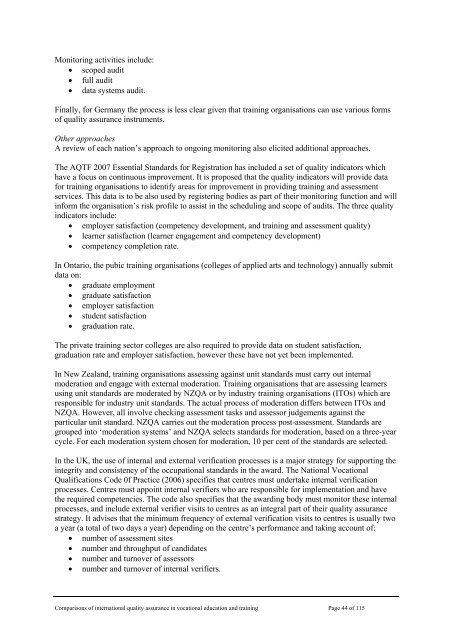Review - Department of Innovation, Industry, Science and Research
Review - Department of Innovation, Industry, Science and Research
Review - Department of Innovation, Industry, Science and Research
You also want an ePaper? Increase the reach of your titles
YUMPU automatically turns print PDFs into web optimized ePapers that Google loves.
Monitoring activities include:<br />
• scoped audit<br />
• full audit<br />
• data systems audit.<br />
Finally, for Germany the process is less clear given that training organisations can use various forms<br />
<strong>of</strong> quality assurance instruments.<br />
Other approaches<br />
A review <strong>of</strong> each nation’s approach to ongoing monitoring also elicited additional approaches.<br />
The AQTF 2007 Essential St<strong>and</strong>ards for Registration has included a set <strong>of</strong> quality indicators which<br />
have a focus on continuous improvement. It is proposed that the quality indicators will provide data<br />
for training organisations to identify areas for improvement in providing training <strong>and</strong> assessment<br />
services. This data is to be also used by registering bodies as part <strong>of</strong> their monitoring function <strong>and</strong> will<br />
inform the organisation’s risk pr<strong>of</strong>ile to assist in the scheduling <strong>and</strong> scope <strong>of</strong> audits. The three quality<br />
indicators include:<br />
• employer satisfaction (competency development, <strong>and</strong> training <strong>and</strong> assessment quality)<br />
• learner satisfaction (learner engagement <strong>and</strong> competency development)<br />
• competency completion rate.<br />
In Ontario, the pubic training organisations (colleges <strong>of</strong> applied arts <strong>and</strong> technology) annually submit<br />
data on:<br />
• graduate employment<br />
• graduate satisfaction<br />
• employer satisfaction<br />
• student satisfaction<br />
• graduation rate.<br />
The private training sector colleges are also required to provide data on student satisfaction,<br />
graduation rate <strong>and</strong> employer satisfaction, however these have not yet been implemented.<br />
In New Zeal<strong>and</strong>, training organisations assessing against unit st<strong>and</strong>ards must carry out internal<br />
moderation <strong>and</strong> engage with external moderation. Training organisations that are assessing learners<br />
using unit st<strong>and</strong>ards are moderated by NZQA or by industry training organisations (ITOs) which are<br />
responsible for industry unit st<strong>and</strong>ards. The actual process <strong>of</strong> moderation differs between ITOs <strong>and</strong><br />
NZQA. However, all involve checking assessment tasks <strong>and</strong> assessor judgements against the<br />
particular unit st<strong>and</strong>ard. NZQA carries out the moderation process post-assessment. St<strong>and</strong>ards are<br />
grouped into ‘moderation systems’ <strong>and</strong> NZQA selects st<strong>and</strong>ards for moderation, based on a three-year<br />
cycle. For each moderation system chosen for moderation, 10 per cent <strong>of</strong> the st<strong>and</strong>ards are selected.<br />
In the UK, the use <strong>of</strong> internal <strong>and</strong> external verification processes is a major strategy for supporting the<br />
integrity <strong>and</strong> consistency <strong>of</strong> the occupational st<strong>and</strong>ards in the award. The National Vocational<br />
Qualifications Code 0f Practice (2006) specifies that centres must undertake internal verification<br />
processes. Centres must appoint internal verifiers who are responsible for implementation <strong>and</strong> have<br />
the required competencies. The code also specifies that the awarding body must monitor these internal<br />
processes, <strong>and</strong> include external verifier visits to centres as an integral part <strong>of</strong> their quality assurance<br />
strategy. It advises that the minimum frequency <strong>of</strong> external verification visits to centres is usually two<br />
a year (a total <strong>of</strong> two days a year) depending on the centre’s performance <strong>and</strong> taking account <strong>of</strong>:<br />
• number <strong>of</strong> assessment sites<br />
• number <strong>and</strong> throughput <strong>of</strong> c<strong>and</strong>idates<br />
• number <strong>and</strong> turnover <strong>of</strong> assessors<br />
• number <strong>and</strong> turnover <strong>of</strong> internal verifiers.<br />
Comparisons <strong>of</strong> international quality assurance in vocational education <strong>and</strong> training Page 44 <strong>of</strong> 115
















